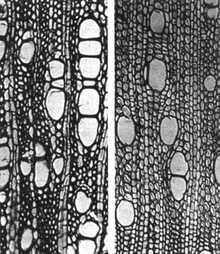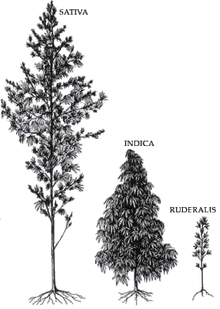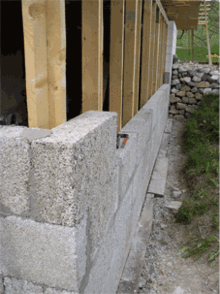Cannabis in Italy
[6] In regard to possible future expansions, it is estimated that with the potential redevelopment of already-existing greenhouses, which either fell into disuse or were abandoned due to the crisis of the horti-floriculture sector, Italy would have ready access to a further 1,000 ha (10.0 km2; 3.9 sq mi) of farm land for the production of medical cannabis within secure environments.
[9][10] In the last few years, the annual event has been held at the Fiera di Roma exhibition center in Rome, with the attendance of as many as 30,000 visitors, as well as several hundreds of both national and international entities, including research institutes, private companies, and universities.
[9][10] Besides providing exposure of the cannabis and hemp sectors to the wider public, the exhibition also aims at supporting the companies that work in these fields, with a list of addressed topics that include biodiversity, sustainability, food, wellness, textiles, constructions, culture, and innovation.
[11][12] In recent years, the annual event has been held at the Unipol Arena in Bologna, with the attendance of as many as 25,000 visitors, as well as hundreds of exhibitors and business professionals, including representatives from ConfAgricoltura, Cia – Agricoltori Italiani, FederCanapa, Assocanapa, Coldiretti, EasyJoint, and The Bulldog.
[11][12] In 2012, a study was published regarding the trace presence of psychotropic substances such as cocaine, cannabinoids, nicotine, and caffeine, in the air of eight major Italian cities, namely Palermo, Turin, Rome, Bologna, Florence, Milan, Naples, and Verona.
[31][32] In 2019, a team of economists from the University of Magna Graecia, Université Catholique de Louvain, and the Erasmus School of Economics published a study on the effect of light cannabis liberalization in Italy on the organized crime.
[41][43] In particular, the Court argued that, given the rudimental techniques used, the small number of plants present, the modest achievable amount of the final product, and the lack of evidence connecting it to a larger narcotic market, the cultivation appeared to be destined exclusively for the personal use of the defendant, and should therefore be considered excluded from the application of the penal code.
[46] Critics have also argued that such serious charges would lead patients to buy cannabis directly from illegal pushers instead of growing it themselves, since they would risk just a fine, confiscation of documents, and a mandatory rehabilitation program for possession, as opposed to 6 years in prison for drug pushing.
[55] Following the removal of the cannabis decriminalization proposal from the referendum of 12 June 2022, the issue resurfaced during the campaign for the snap general election that was held on 25 September 2022, after the resignation of the then Prime Minister Mario Draghi on 21 July 2022.
[58] Even though the Brothers of Italy party, led by the subsequently-elected Prime Minister Giorgia Meloni, did not explicitly mention cannabis legalization during their campaign, other than labeling the drug as one of the youthful deviances that need to be tackled with the promotion of healthy lifestyles, their leader had discussed the subject multiple times in the past.
[60] The cultivation of cannabis plants for pharmaceutical use, as well as the production and distribution of cannabis-based medicine, are allowed only for authorized entities, while the DPR 309/90 forbids both the direct and indirect advertisement of a list of derived substances.
[60] In November 2015, Italy instituted the Central Office for Narcotics, in accordance with the 1961 UN Convention and subsequent amendments, which instruct countries allowing the cultivation of cannabis for medical purposes to create a state agency for its management.
[64] The GIA branch manages training and educational activities at both a national and international level through courses, conferences, and workshops; and it also gives technical-juridical advice with regards to bills and regulations on narcotics and drug trafficking.
[28][55] The overall economic activities resulting from the black market for narcotics in Italy are valued at 16.2 billion euros, of which about 39% can be attributed to the consumption of cannabis derivatives, and almost 32% to cocaine use, as inferred from a Parliamentary report on drug addiction.
[28] Furthermore, both consumption rates and prices have reportedly remained the same in the previous ten years, with the only significant change being the exponential increase in personal cannabis cultivations, mainly due to the particularly favorable Italian climate.
[70] More recently, the Army's activities facilitated a steady increase of its involvement in the public health sector, that further accelerated during the COVID-19 pandemic, for which military personnel was charged to set up treatment tents and transport vaccines.
[90] An innovative method implemented by the consortium, for the extraction of active principles from medical cannabis, is a cryogenic process in which the low temperatures allow to reduce the preparation time for the final product from 2 or 3 days to about 15 minutes.
[90] Another noteworthy application of cannabis-based medications is in dermatology; for instance, a novel cosmetic line by the Swiss lifescience company Crystal Hemp combines CBD with resveratrol, azelo-glycine, and lactobionic acid, to regulate the production of sebum in sebaceous glands, reduce redness of the skin, and inducing exfoliation.
[94] In regard to international travel, a decree issued by the Ministry of Health on 16 November 2007 details all the rules and procedures that should be followed, to allow the carrying of small quantities of medical preparations containing narcotic drugs and psychotropic substances for personal use.
[6] Furthermore, the legislation also encourages educational activities, such as training for those who operate in the supply chain for industrial cannabis, to illustrate the properties of hemp plants, as well as their use in the agronomic, agroindustrial, nutraceutical, bio-building, biocomponent, and packaging fields.
[6] In fact, the aim of the Law 242/16 is to stimulate the production of industrial hemp in the country, as well as to offer an alternative to the cultivation of wheat for farmers damaged by low prices, desiccated lands, and competition from large corporations importing grain from abroad.
[96] The cultivation of industrial hemp with minimal levels of psychoactive compounds has several commercial applications, including food, fabrics, clothing, biofuel, building materials, as well as animal feed and bedding.
[5] Furthermore, in terms of the nutritional value, hemp seeds contain all essential amino acids in optimal proportions and in an easily digestible form, as well as high levels of protein and considerable amounts of fibers, vitamins, Omega-3, and minerals; and the wide range of edible products includes biscuits, taralli, bread, flour, anti-inflammatory oil, ricotta, tofu, and beer.
[107] In regard to the construction industry, building materials that can be derived from hemp include mortar, plaster, finishing products, thermally insulating panels, bricks, and ecobricks, as well as hemp-cement and hemp-lime biocomposites.
[3] In 2016, a study by the ENEA research center in Brindisi highlighted how the use of hemp-based materials for sustainable buildings resulted in slower propagation of structure fires; higher transpiration and resistance to bacteria; as well as improved energy performances, since their lower thermal conductivity reduces the need for air conditioning, especially in the warm temperate areas of the Mediterranean region.
[108] As buildings are responsible for a large part of the national energy consumption in Italy, with further ENEA studies showing that households alone account for 45% of CO₂ emissions in the country, hemp-base materials constitute a significant innovation potential for the construction sector.
[109] Examples of applications include the removal of radioactive strontium and cesium from areas affected by the Chernobyl nuclear disaster of 1986, for which the pilot project started in 1998; as well as the removal of toxic chemical dioxins from farm lands and grazing fields around the Ilva steel plant near Taranto, with the project starting in 2012 after the establishment in 2010 of an exclusion zone for grazing livestock up to 20 km (12.4 mi) from the plant, due to the high levels of dioxins, lead, nickel, and tens of other toxic substances in the ground.
[109] Besides their presence in the soil either as natural elements or as a result of pollution, another anthropogenic source of heavy metals in some farm lands has been their continued historical use as a predominant pesticide, and all these factors could negatively affect the consumers of cannabis-derived products.
[114] The various experimental sites, each covering about 0.5 ha (5,000.0 m2; 1.2 acres), were sampled beforehand and subjected to pedological assessment, and subsequently planted with the Uso 31, Felina 32, and Futura 75 hemp varieties, to study the crop's bio-morphological parameters.
[113] In 2023, a scientific study was published regarding the phytoremediation potentials of the monoecious Futura 75 and KC Dora hemp varieties, as well as the effects of the pollutants on the crop yield, after a two-year experiment carried out by the University of Catania analyzed test soils that were purposefully contaminated with different levels of three heavy metals, namely cadmium, lead, and nickel.





















